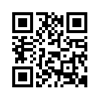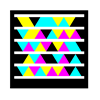
QR Code for SCO
Web site.
You’ve probably seen QR codes in magazine ads, newspapers, signs, even on T-shirts, but what are they, and how do they work? Quick Response (QR) codes have been around since the mid 1990’s, but the explosive growth of smartphones over the last couple of years has fueled their widespread implementation. At the SCO, we recently jumped on the bandwagon and added QR codes to most of our printed publications.
A QR code is simply a two-dimensional barcode that lets you encode a variety of data into a two-color matrix. A Web URL is the most common thing to encode. But I’m also starting to see QR codes show up on business cards, making it quick and easy to import contact info into your contacts list.
Here’s how it works: you install a QR reader on your smartphone, then “scan” the code with your camera. If the encoded data is a Web URL, it will automatically launch your default browser, and load up the URL. Exactly how data are encoded in QR codes is way over my head, but if you are the curious sort, head over to Wikipedia for more information.
There are a number of competing standards for two-dimensional barcodes. You’ve probably seen examples of Microsoft’s Tag Barcodes in magazines. Conceptually, they operate in basically the same way as a QR code, but the specific methodology to encode and read data is much different. For any number of reasons, it appears these haven’t caught on as quickly as QR codes.

Microsoft Tag
Barcode for SCO
Web site.
Microsoft produces a tag reader app for all the major mobile phone platforms. Interestingly, the Microsoft app supports both QR codes and Tag Barcodes. In fact, on the iPhone I’ve found the Microsoft app to be superior to other QR reader options I’ve tried.
What does this mean for mappers?
QR codes have many potential uses in the world of mapping. Consider the utility of including a QR code in the margin of map on public display. The QR code might, for example, take a person to a Web site where they can learn more about the story behind the map. You can also encode a simple latitude/longitude coordinate that pops up a location on a standard Google map when the user scans your code.
We all know the world has gone mobile, so what about tracking where your QR code was scanned? That’s what the folks at qrd°by have done. Visit their site, type in the URL for whatever you want to share, and they generate a QR code for you. When a user scans the code, they are first redirected to the qrd°by site where their location is grabbed, and then are sent along to your URL. You can later visit qrd°by and see a map of where users are scanning your code. Scary and cool at the same time!
To get started with QR codes, I recommend checking out a site called QR Stuff. They offer a simple tool for generating codes, examples of how QR codes can be used, and some additional background material on how they work. For information on Microsoft’s offerings, visit the Microsoft Tag site. Good luck!
